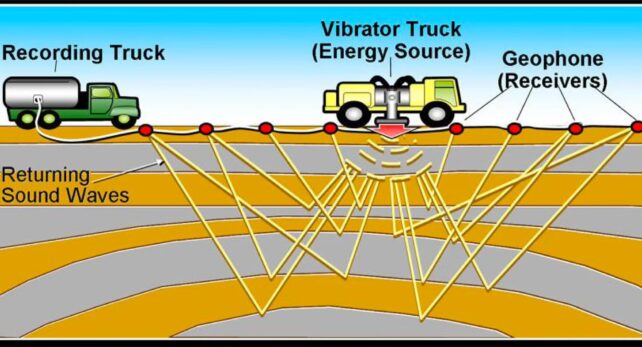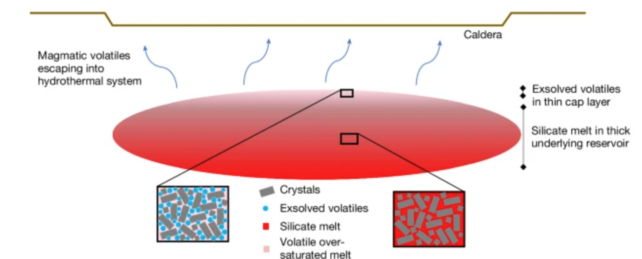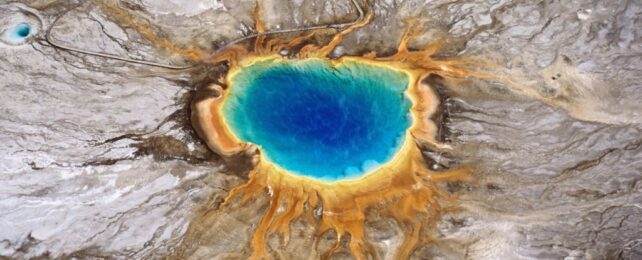Scientists in the United States have 'blown the lid off' the Yellowstone supervolcano's mysterious underground reservoir of magma.
A team of geologists and Earth scientists now claims to have finally found the deep magma 'cap' that keeps the volcanic system's high pressures and temperatures locked up underground.
The lid to this volatile Pandora's box exists between 3.5 and 4 km (2.2 and 2.5 miles) below the northeastern part of the Yellowstone caldera, according to new models – and it seems to be regularly letting out little belches of gas, holding an explosion at bay.
Scientists liken the effect to steady breathing, as if the volcano was in a peaceful slumber. But if enough air was restricted in the supervolcano's 'throat', then at some point an eruptive snore could bellow forth.
Thankfully, the magma cap works sort of like a CPAP machine, keeping internal pressures relatively stable, allowing the supervolcano to sleep somewhat soundly.
"For decades, we've known there's magma beneath Yellowstone, but the exact depth and structure of its upper boundary has been a big question," explains Earth scientist Brandon Schmandt from Rice University. "What we've found is that this reservoir hasn't shut down – it's been sitting there for a couple million years, but it's still dynamic."
Today, abundant evidence suggests that there is a magma reservoir sitting in Earth's crust, just beneath the northeastern part of the Yellowstone caldera. How deep that reservoir lies and how much magma it holds, however, are still up for debate – making it challenging to predict when the supervolcano will next blow its top.
Schmandt's co-lead author Chenglong Duan developed a new method to image Earth's crust in the Yellowstone region. The technique relies on sending seismic waves, akin to tiny earthquakes, into the ground from a vibrating truck to see how they travel through rock layers.
As these waves reflect back to the surface, they are collected by hundreds of seismometers. Collaborating with geophysicist Jamie Farrell from the University of Utah, the team developed an algorithm that reads through all this noisy data to create a model of layers in Earth's crust.
It has now provided what Duan says are the "first super clear images of the top of the magma reservoir beneath Yellowstone caldera."

About 3.8 kilometers below the surface, the probing seismic waves encountered a sudden boundary. They no longer appeared as though they were flowing through rock. Instead, their sluggish movements suggested they were moving through a muddy mixture of supercritical fluid and magma between 3 and 8 kilometers deep.
The scientists have interpreted this boundary as the "sharply defined top of the magma reservoir."
Based on Schmandt and his colleagues' best-fitting models, half of this magma cap is occupied by bubbles of volatile materials. It can be considered a 'self-sealed' lid because the cap is only slightly porous. This means it lets out a small fraction of trace gases, keeping the overall pressure below relatively stable.
Beneath the lid, the top of the magma reservoir seems to be composed mostly of supercritical water, which is heated and pressurized to a point where the line between liquid and gas blur, as well rhyolite magma, which tends to erupt explosively if given the opportunity.

The only thing stopping such an eruption is the gradual cooling and crystallization of sludgy material in the upper crust, which creates this minimally leaky magma cap.
"Given that the estimated total porosity at the top of the reservoir (approximately 14 percent) is well below typical eruptive porosities, our results align with previous assessments that this caldera-forming volcanic system is in a state of repose," conclude the team.
As Schmandt further explains, "it looks like the system is efficiently venting gas through cracks and channels between mineral crystals, which makes sense to me given Yellowstone's abundant hydrothermal features emitting magmatic gases."
In other words, all that activity on the surface of the Yellowstone caldera is a comforting sign, not necessarily a concerning one.
In the past two million years, the Yellowstone supervolcano has flipped its lid three times with extremely large, explosive eruptions. When it will blow again is unknown, largely because we don't know enough about its hidden magma reservoir, or other geological forces like moving tectonic plates, that might impact the system's volatility.
The good news is that recent evidence suggests the risk of a Yellowstone super-eruption is decreasing, which means we probably aren't due for a landscape-destroying tantrum any time soon.
Geysers may keep exploding in front of tourists, and swarms of small earthquakes may shake the region for periods of time, but studies generally suggest the volcano is in a state of repose. Scientists at the United States Geological Survey predict the risk of a Yellowstone super-eruption is about 0.00014 percent each year, based on the timing of previous explosions.
Yellowstone's 'breathing' magma cap brings yet another collective sigh of relief.
The study was published in Nature.
